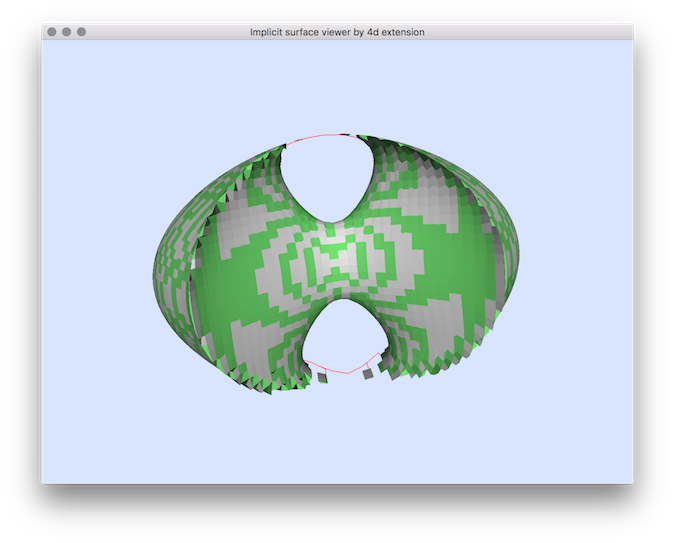3dImplicitSurfaceExtractorBy4DExtension
Computes the zero level set of the given polynomial.
Usage: 3dImplicitSurfaceExtractorBy4DExtension [options] input
Allowed options are :
-h [ --help ] display this message
-p [ --polynomial ] arg the implicit polynomial whose
zero-level defines the shape of
interest.
-a [ --minAABB ] arg (=-10) the min value of the AABB bounding box
(domain)
-A [ --maxAABB ] arg (=10) the max value of the AABB bounding box
(domain)
-g [ --gridstep ] arg (=1) the gridstep that defines the
digitization (often called h).
-t [ --timestep ] arg (=9.9999999999999995e-07)
the gridstep that defines the
digitization in the 4th dimension
(small is generally a good idea,
default is 1e-6).
-P [ --project ] arg (=Newton) defines the projection: either No or
Newton.
-e [ --epsilon ] arg (=9.9999999999999995e-08)
the maximum precision relative to the
implicit surface.
-n [ --max_iter ] arg (=500) the maximum number of iteration in the
Newton approximation of F=0.
-v [ --view ] arg (=Normal) specifies if the surface is viewed as
is (Normal) or if places close to
singularities are highlighted
(Singular).
Example:
3dImplicitSurfaceExtractorBy4DExtension -p "-0.9*(y^2+z^2-1)^2-(x^2+y^2-1)^3" -g 0.06125 -a -2 -A 2 -v Singular -t 0.02
You could also use other implicit surfaces:
- whitney : x^2-y*z^2
- 4lines : x*y*(y-x)*(y-z*x)
- cone : z^2-x^2-y^2
- simonU : x^2-z*y^2+x^4+y^4
- cayley3 : 4*(x^2 + y^2 + z^2) + 16*x*y*z - 1
- crixxi : -0.9*(y^2+z^2-1)^2-(x^2+y^2-1)^3
You should obtain such a result:

resulting visualisation.
 1.9.1
1.9.1